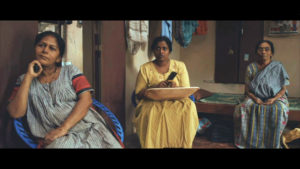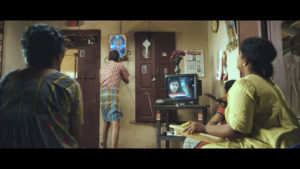Renu Susan explores how smartphones have transformed women’s TV-viewing practices in contemporary times, and carry implications for identity formation, independence, and a sense of oneself.
Renu Susan Jacob
In the popular Malayalam cinema Maheshinte Prathikaram (2016), there is a scene in which, having lost all his gooseberries to a hoard of school-leaving children, Jose (Jayashankar) returns home angry and calls out to his wife Elsy (Manju Pathrose) to bring him a glass of water. The lack of response from his wife and the loud background music of a TV serial coming from inside the house further infuriates Jose. As he storms indoors to pull out the TV’s plug, we see that Elsy is not the sole viewer. She is accompanied by two other middle-aged women who are implied to be their neighbours. The ruckus that ensues is marked by the silence of the TV and the women being forced to disperse into the inner rooms of the home or to their own homes. The scene shows how the untimely return of the husband disrupts the women’s sense of space and time within their home that is linked to their access to entertainment and control over media.


Literary works such as Virginia Woolf’s A Room of One’s Own have discussed the historical significance of women’s access to space and time alone within the home. Woolf argues the importance of claiming spaces of privacy for women’s writing. In it lies the ability to make choices, form identities, and develop a sense of oneself. In the contemporary world that is driven by mass media—and more lately by digital media—having control over, and confidence about, one’s viewing practices are similarly important. While the processes of reading and writing are considered solitary occupations, the viewer-consumer of mass media is located within groups/communities/families. This is where I position the importance of the smartphone in the lives of the modern-day homemaker. It allows the homemaker a claim to exercise their own choices and carve a sense of the self within the public home. In this article, I would like to look at the shifting access and relation of women to “their” phones and emphasise why we need to look closely at the gender differentiation with which we normativise technology.
TV-Watching at Home
Women’s TV-viewing practices have occasionally been portrayed in contemporary Malayalam cinema, often limited to melodramatic serial or devotional TV programmes. In the 2017 movie CIA (Comrade in America), the ominous music of the TV serial being watched by the mother is used to frame the tension of the parents meeting their son’s girlfriend for the first time. Another subtle yet striking scene that throws light on women’s everyday viewing practices is in the 2019 film Kumbalangi Nights. Babymol’s mother (Ambika Rao) is shown to mute the TV as she hears her son-in-law returning from work. Following this, the male protagonist encourages them to watch the news instead of TV serial melodrama, making clear the gendered hierarchy of these two kinds of shows.
The space of the living room and the presence of the homemaker woman in front of it have grown into a taken-for-granted image in many of our minds. And more often than not, the interruption of the watching process becomes the tension-reliever that takes the scene forward. Even within our everyday lives, TV viewing practices of women have been subject to mockery over their choices of programmes, if at all the choice rests with them. The occupation of the public living room by the homemaker and the control of the TV remote become points of scrutiny, judgement, and criticism, which are reflected in the movie scenes described above.
As modern-day mass media, both television and then the internet have been celebrated for their democratic and participatory potential. While this is the case in many scenarios, the gender differentiation of this potential points out that regional cultural politics play a heavy role in defining media experiences. As recently as March 2021, a survey of television viewing practices in urban households conducted by Ormax Media shows that the control of the television remotes during primetime goes to men, while women can claim the same on weekdays during afternoons and early evenings.
Mastering the Smartphone
Smartphone usage among women, mostly urban women, is said to have increased in recent years in the country. The nature and degree of this use vary across households, with second-hand or spare phones (that replace the landline) often falling into the hands of homemakers as other family members go for new models. The degree of the use of this device, in terms of what applications are used, have slowly but steadily increased with help from family members or friends. The stand-up comedian Kanan Gill, in the show titled Keeping It Real, recollects his experience of teaching his mother the process of taking a screenshot on the phone. Gill narrates the story of asking his mother to press the home button and the lock button at the same time for taking a screenshot but being faced with questions like ‘The home button is which button?’ and ‘At the same time? But how does it [the phone] know?’ He jokingly refers to his own realisation that an iPhone has three keys, rather than his earlier assumption of it having only one, during this process. While the internet and digital media theoretically represent individual and solitary participation, the varying degree of access and use that different gender and age groups can claim over these media, along with the influence of regional and cultural politics, present a complex cultural phenomenon that requires further study.
Viewing Content to Producing Content
We see the ever-increasing number of YouTube channels made by women dealing with topics of family, homemaking, domesticity etc. along with increased female participation in viewership, as visible in the comment sections and further engagements in social media. This shows that increased access to infrastructure and media via smartphones has allowed women to engage with these at a more solitary and individual level that is not possible with the commonly shared television set at home. The value that the smartphone holds and is capable of generating is crucial for women’s growth and progress.
Last year, as the pandemic lockdowns were put in place and children and other family members were brought back to their homes with schools and offices being shut, the question of access to personal devices became more significant. The smartphone that the homemaker mother owned and used immediately acquired a shared-ownership implication. It became the device for a child’s access to classes or a device for a shared hotspot connection, rather than the woman’s device. The use and ownership of the device were conveniently shifted to the space of the communal from the personal. We have also seen or heard about the school and college teachers, many of them women, struggling to navigate learning management systems and video conferencing software along with familiarising themselves with microphones, Bluetooth earphones and other hardware. This precarious relationship that the woman has with a smartphone has implications beyond ownership or status claims. The value of having a claim over one’s own device in a digital age and having the space to view, access, and develop it is a crucial aspect of our world today.
By throwing light on mass media and digital media practices that are part of women’s lives, I have attempted to situate the idea of privacy within the space of the home as profoundly gendered. If we borrow from Woolf, the possibilities of ‘a smartphone of one’s own’ offers a crucial image for our contemporary times that carry implications for identity formation, independence, and a sense of oneself. I will leave readers with the image of Elsy viewing a YouTube video on her smartphone with earphones.
About the Author: Renu is pursuing her PhD in Cultural Studies at The English and Foreign Languages University, Hyderabad, and trying to find her niche in digital media studies and life-narratives.
